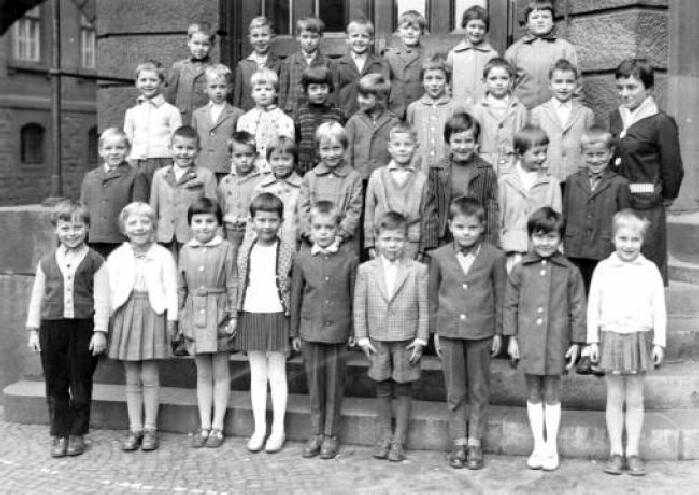
Unidentified German Primary School (1961)

Figure 1.-- Here we see what we believe is a German 1st or 2nd year class which would mean children about 6-7 years old. We do know the portrait was taken in 1961. Unfortunately
we do not know the name of the school or the exact location. And we are not able to identify if the school was in East or West Germany which would be helpful in understanding fshion trends. We might guess that it was a West German school because the children look very well dressed and some are wearing tights. Major changes occurred in German children's fashions during
the late 1950s and early-60s and these school portraits are helpful in tracking such changes. We also see changes in the scools themselves such as the increasing popularity of coeduction.
|
|
Here we see what we believe is a German 1st or 2nd year class which would mean children about 6-7 years old. We do know the portrait was taken in 1961. Unfortunately
we do not know the name of the school or the exact location. And we are not able to identify if the school was in East or West Germany which would be helpful in understanding fshion trends. We might guess that it was a West German school because the children look very well dressed and some are wearing tights. Major changes occurred in German children's fashions during
the late 1950s and early-60s and these school portraits are helpful in tracking such changes. We also see changes in the scools themselves such as the increasing popularity of coeduction. A major fashion change was the appearance of tights and the rapid replacent of long stockings. (This trend was not as rapid in East Germany.) The girls here wear short dresses with tights, white or beige. Many of the boys wear long trousers whch were also becoming more popular, but some wear short trousers with either long stockings or tights. Unlike Americam, tights in German were not preceived as a girls' garment.
Notice the boy in the front row with brown stockings or tights, ot is not always easy to differentiate. Tights had become quite common in West Germany by 1961 (they seem to have been introduced commercially in Germany for boys and girls about 1958-59). Some conservative mothers were less willing to change. They preferred to continue dressing their children in long stockings, even into the early-1960s. Stockings were cheaper and more durable. Some boys also preferred long stockings to tights because they could be unfastened from supporters and rolled down on warmer days whereas this was not possible with tights. Also tights could wrinkle on legs if they were not perfectly sized, but of course they did make the wearing
of Leibchen unnecessary and eliminiated the problem of supporter clasps showing under trousers that were too short.
HBC-SU

Related Chronolgy Pages in the Boys' Historical Web Site
[Main Chronology Page]
[The 1900s]
[The 1910s]
[The 1920s]
[The 1930s]
[The 1940s]
[The 1950s]
Navigate the German school pages
[Return to the Main German 1960s individual school chronology page]
[Return to the Main German individual school chronology page]
[Return to the Main German school uniform page]
[Imperial Germany]
[Weimar Republic]
[NAZI era]
[Post-war Years]
[Modern Germany]
[Return to the Main school uniform page]
[Return to the Main school uniform national page]
Navigate the Relate Boys Historical Clothing Style Pages
[Main country page]
[Long pants suits]
[Short pants suits]
[Lederhosen]
[Kneesocks]
[Eton suits]
[Jacket and trousers]
[Blazer
[School sandals]
Navigate the Boys' Historical Clothing School Uniform Pages
[Main School Uniform Page]
[Australia]
[England]
[France]
[Germany]
[Italy]
[Japan]
[New Zealand]
[Scotland]
[United States]
Navigate the Boys' Historical Clothing Web Page
[Introduction]
[Activities]
[Biographies]
[Chronology]
[Clothing styles]
[Countries]
[Girls]
[Bibliographies]
[Contributions]
[FAQs]
[German glossary]
[Images]
[Links]
[Registration]
[Boys' Clothing Home]
Created: 3:06 PM 11/11/2008
Last updated: 3:06 PM 11/11/2008




